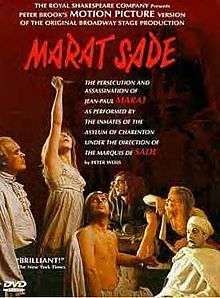Marat/Sade (film)
| Marat/Sade | |
|---|---|
 DVD cover | |
| Directed by | Peter Brook |
| Produced by | Michael Birkett |
| Screenplay by |
Adrian Mitchell English translation: Geoffrey Skelton |
| Based on |
Marat/Sade by Peter Weiss |
| Starring |
Patrick Magee Ian Richardson Michael Williams Clifford Rose Glenda Jackson Freddie Jones |
| Music by | Richard Peaslee |
| Cinematography | David Watkin |
| Edited by | Tom Priestley |
| Distributed by | United Artists |
Release date |
|
Running time | 116 minutes[1] |
| Country | United Kingdom |
| Language | English |
The Persecution and Assassination of Jean-Paul Marat as Performed by the Inmates of the Asylum of Charenton Under the Direction of the Marquis de Sade, usually shortened to Marat/Sade (pronounced [ma.ʁa.sad]), is a 1967 British film adaptation of Peter Weiss' play Marat/Sade. The screen adaptation is directed by Peter Brook, and originated in his theatre production for the Royal Shakespeare Company. The English version was written by Adrian Mitchell from a translation by Geoffrey Skelton.
The cast included Ian Richardson, Patrick Magee, Glenda Jackson, Clifford Rose, and Freddie Jones. It was filmed at Pinewood Studios in Buckinghamshire and released by United Artists on 22 February 1967 in the United States, and 8 March 1967 in the United Kingdom. The film's score comprised Richard Peaslee's compositions. David Watkin was the cinematographer.[2] The film uses the full title in the opening credits, though most of the publicity materials use the shortened form.
Plot
In the Charenton Asylum in 1808, the Marquis de Sade stages a play about the murder of Jean-Paul Marat by Charlotte Corday, using his fellow inmates as actors. The director of the hospital, Monsieur Coulmier, supervises the performance, accompanied by his wife and daughter. Coulmier, who supports Napoleon's government, believes that the play will support his own bourgeois ideas, and denounce those of the French Revolution that Marat helped lead. His patients, however, have other ideas, and they make a habit of speaking lines he had attempted to suppress, or deviating entirely into personal opinion. The Marquis himself, meanwhile, subtly manipulates both the players and the audience to create an atmosphere of chaos and nihilism that ultimately brings on an orgy of destruction.
Cast
- Patrick Magee as Marquis de Sade
- Ian Richardson as Jean-Paul Marat
- Michael Williams as Herald
- Clifford Rose as Monsieur Coulmier
- Glenda Jackson as Charlotte Corday
- Freddie Jones as Cucurucu
- Jonathan Burn as Polpoch
- Jeanette Landis as Rossignol
- Hugh Sullivan as Kokol
- John Hussey as Newly Rich Lady
- W. Morgan Sheppard as A Mad Animal
- John Steiner as Monsieur Dupere
- Henry Woolf as Father
Reception
Film review aggregator Rotten Tomatoes reported an approval rating of 100%, based on 12 reviews, with an average rating of 7.8/10.[3]
Roger Ebert wrote, "The actors are superb. When we first see the Marquis (Patrick Magee), he looks steadily into the camera for half a minute and the full terror of his perversion becomes clearer than any dialog can make it. Glenda Jackson, as Marat's assassin Charlotte Corday, weaves back and forth between the melancholy of her mental illness and the fire of the role she plays. Ian Richardson, as Marat, still advocate violence and revolution even though thousands have died and nothing has been accomplished." [4]
Film critic Leonard Maltin awarded the film 4 out of a possible 4 stars, calling the film "chilling", praising the film's atmosphere as being "...so vivid that it seems actors are breathing down your neck".[5]
Accolades
Brook shared the Nastro d'Argento for Best Director of a Foreign Film with Robert Bresson, who was honored for Mouchette, and received Special Mention at the Locarno International Film Festival.
References
- ↑ "THE PERSECUTION AND ASSASSINATION OF JEAN-PAUL MARAT AS PERFORMED BY THE INMATES OF THE ASYLUM OF CHARENTON UNDER THE DIRECTION OF THE MARQUIS DE SADE (X)". British Board of Film Classification. 30 November 1966. Retrieved 19 March 2014.
- ↑ Watkin, David. "Filmography". The David Watkin Archive. Retrieved 12 August 2015.
- ↑ "Marat/Sade (1966)". Rotten Tomatoes. Fandango Media. Retrieved 29 June 2018.
- ↑ Ebert, Roger. "Marat/Sade Movie Review & Film Summary (1967) - Roger Ebert". www.rogerebert.com.
- ↑ Maltin, Leonard (2 September 2014). Leonard Maltin's 2015 Movie Guide. Penguin Publishing Group. p. 896. ISBN 9780698183612.
External links
- Marat/Sade on IMDb
- Marat/Sade at Rotten Tomatoes
- Marat/Sade at AllMovie
- Marat/Sade at the TCM Movie Database
| Wikiquote has quotations related to: Marat/Sade |